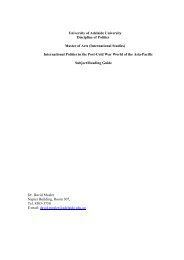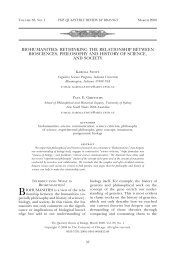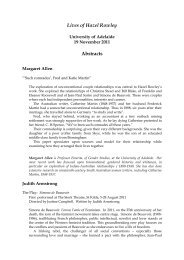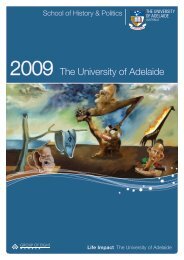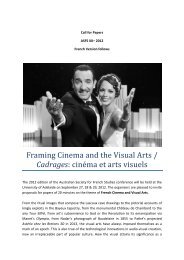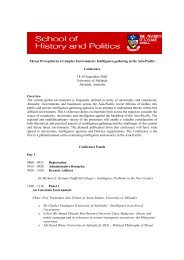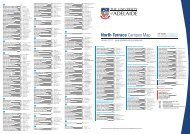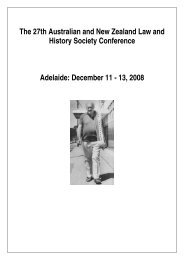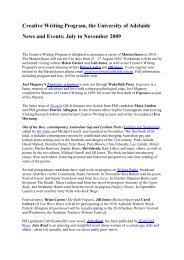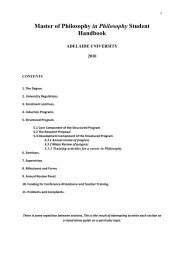Introduction - Faculty of Humanities & Social Sciences
Introduction - Faculty of Humanities & Social Sciences
Introduction - Faculty of Humanities & Social Sciences
You also want an ePaper? Increase the reach of your titles
YUMPU automatically turns print PDFs into web optimized ePapers that Google loves.
Introdu ctio n 4<br />
proposing their own definitions <strong>of</strong> emotion and motivation. As far as I can tell, their proposals<br />
have had little or no influence. That is because a definition, by itself, is never enough.<br />
Definitions <strong>of</strong> scientific concepts are verbal, as against formal, techniques for representing<br />
the phenomena <strong>of</strong> a domain <strong>of</strong> enquiry and thus are inextricably bound to theory (Toulmin<br />
1972). ‘Natural selection’ means what it does in the context <strong>of</strong> Darwin’s theory <strong>of</strong> evolution;<br />
‘quark’ means what it does in the context <strong>of</strong> the Standard Model <strong>of</strong> atomic physics. As part <strong>of</strong><br />
the “empirical content” <strong>of</strong> a theoretical framework, scientific concepts connect not only to a<br />
science’s explanatory goals but also to its explanatory procedures and standards <strong>of</strong> adequacy<br />
(Popper 2002:96). The significance <strong>of</strong> a concept within a historically developing scientific<br />
enterprise is thus determinable only within a complex context that includes, according to<br />
Toulmin (1972), “subject-matter, formal entailments, [and] explanatory procedures,” which are<br />
themselves embedded within a larger framework that specifies “on what conditions, in what<br />
kinds <strong>of</strong> case, and with what degree <strong>of</strong> precision” the concept has meaning at all (p. 185).<br />
Chapter 1 shows that it is precisely these fundamental issues that remain currently ambiguous<br />
in the sciences concerned with cognition. If anything, cognition is even more vague and<br />
polysemic than emotion and motivation, if only because it all too <strong>of</strong>ten appears to serve as<br />
“little more than a synonym for sophisticated information processing” (Toates 1995:239).<br />
After delineating the shape <strong>of</strong> the gap, Chapter 1 closes with an outline <strong>of</strong> the capacities<br />
and properties for which a general theory <strong>of</strong> cognition, ideally, should account. In total, a<br />
dozen capacities and properties are identified: affect, anticipation, awareness, discrimination,<br />
memory, perception, self-reference, motivation, decision making, error correction, learning, and<br />
communication. Collectively these capacities yield two properties—intentionality and<br />
normativity—that have been widely discussed by philosophers as suggestive (if not indicative)<br />
<strong>of</strong> mind. Phenomenal consciousness—in Damasio’s sense <strong>of</strong> “the feeling <strong>of</strong> what happens” or<br />
Nagel’s what-it-is-like-to-be—is bracketed on the basis <strong>of</strong> the ‘problem <strong>of</strong> other minds’. 3 As we<br />
will see in Chapter 2, liberality or parsimony in attributing phenomenal consciousness to<br />
nonhuman animals is arguably a function <strong>of</strong> usually implicit underlying presuppositions.<br />
If a general theory <strong>of</strong> cognition is the aim, how to proceed? Chapter 2 identifies two<br />
general approaches to the problem <strong>of</strong> cognition that differ in underlying methodological<br />
assumptions. These assumptions relate to the most productive starting point <strong>of</strong> enquiry and are<br />
usually implicit. What I call the anthropogenic approach assumes that the best way to approach<br />
cognition is to start with the most certain example—human cognition—and abstract the<br />
relevant features. Depending upon what is taken to be diagnostic, the resulting theoretical<br />
construct may (or may not) apply to other animal species and intelligent machines. The biogenic<br />
approach, by contrast, assumes that the best way to approach cognition is to recognize that it<br />
is, first and foremost, a biological function—it assists an organism to make a living in an everchanging<br />
environment—and should be approached as such. In other words, the biogenic<br />
approach assumes that the best way to build a characterization <strong>of</strong> what cognition is and what<br />
cognition does is to begin with the principles <strong>of</strong> biology. Psychological questions are posed as<br />
biological questions; for example, what is it that organisms do such that they might require<br />
3<br />
The ‘problem <strong>of</strong> other minds’ arises from the privacy <strong>of</strong> human thought and personal experience. We cannot know for certain that<br />
another person is conscious except by virtue <strong>of</strong> her verbal confirmation. Yet, she might be lying. The assumption is, therefore, that<br />
similar brain structure—the argument from analogy—guarantees more or less similar experience. But how similar need another<br />
brain be? We cannot know in the absence <strong>of</strong> verbal confirmation, and so on infinitely. To date, the problem has been ‘solved’<br />
effectively by convention, which many are loath to apply to nonhuman animals.



